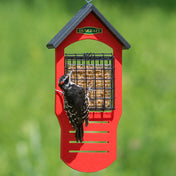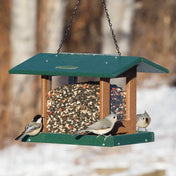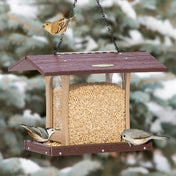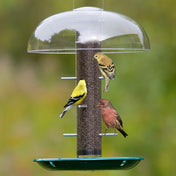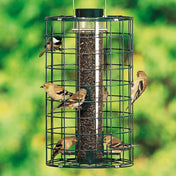Keep Birds Healthy: How to Safely Clean Feeders & Baths
At Duncraft, we know the joy of watching wild birds visit your yard never gets old. Offering food and fresh water is one of the best ways to help them, especially during challenging seasons. But to truly keep your feathered friends safe, there’s one more important step—keeping your feeders and bird baths clean.
Clean feeding stations help prevent the spread of harmful bacteria, mold, and diseases that can quickly pass from bird to bird. The good news? A little regular maintenance goes a long way toward keeping your backyard flock healthy and thriving.
Why Bird Feeder Hygiene Matters
Birds often gather in close quarters around feeders and baths. While this creates great photo opportunities for you, it can also mean more opportunities for germs to spread. Leftover seed shells, droppings, and stagnant water can harbor bacteria like salmonella or attract unwanted pests.
By committing to a simple cleaning routine, you’re doing more than feeding birds—you’re protecting them.
How Often to Clean
- Bird Feeders: Clean thoroughly at least once a week—more often during wet or warm weather.
- Bird Baths: Change the water daily to keep it fresh and free from debris.
- High-Traffic Feeders: If you notice heavy bird activity or spilled seed, clean more frequently.
A clean feeding station is a healthy feeding station.
Step-by-Step: Safe Cleaning for Feeders & Baths
- Wear gloves and clean your feeders outside.
- Disassemble the feeder so you can reach every surface.
- Scrub with a non-toxic disinfectant such as Bird Feeder Cleaner or use a mild 5% bleach solution. If neither is available, warm soapy water works in a pinch.
- Use the right brush—a long-handled brush for tube feeders, a soft brush for baths, and smaller brushes for feeding ports and crevices.
- Rinse well to remove all cleaning solution.
- Air dry completely before adding fresh seed or water.
- Wash your hands after handling feeders or baths.
Tips for Safer Feeding
Flat feeding surfaces like trays and tables make seed more accessible—but they also can attract a crowd. To reduce the spread of germs, keep these areas especially clean and consider rotating them with hanging tube feeders or suet feeders.
And don’t forget—location matters! Place feeders where droppings won’t contaminate water sources, and space them apart to avoid overcrowding.
Your Role in Bird Safety
By keeping feeders and baths clean, you’re helping protect the birds in your care and contributing to healthier local bird populations. At Duncraft, we design many of our feeders with easy-clean features, durable materials, and bird-friendly construction so you can enjoy birdwatching while giving birds the safest possible space to feed and drink.
Shop our Duncraft Bird Feeders and Bird Baths to make healthy bird feeding a simple, rewarding part of your routine.
Thanks for reading, and happy birding!
A trusted source in bird feeding since 1952. Visit our website to see all our products.


